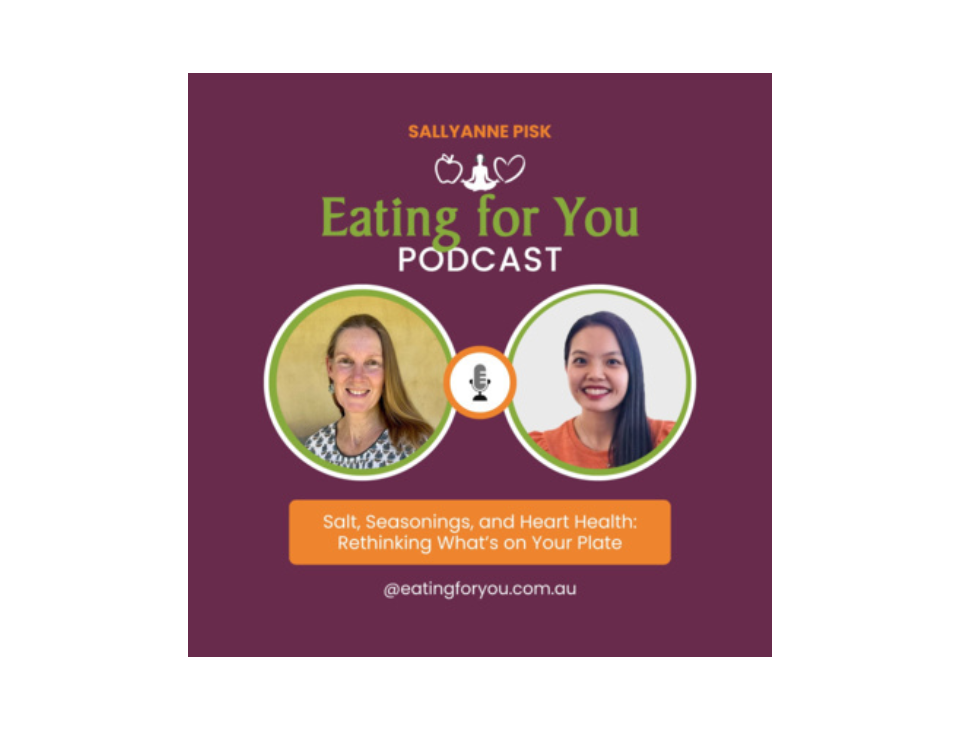Celebrate Heart Week with Heart health in culturally diverse populations: Insights from our founding dietitian on the Dietitian Connection Podcast
In a special Heart Week episode, our founding dietitian Dr Rebecca Luong was invited to speak on the Dietitians Connection Podcast. She talked about heart health and how to eat well while keeping the cultural foods you love. Here’s a simple guide to what she shared!
What Is Cardiovascular Disease and Heart Disease? Are They the Same?
Cardiovascular disease includes all diseases concerning the blood vessels and heart. It includes heart disease, cerebrovascular disease (blood vessels supplying the brain e.g. strokes), peripheral artery diseases (blood vessels supplying body parts outside of the heart or brain e.g. legs).
Heart disease is a type of cardiovascular disease and includes all disease affecting the heart structure and function such as coronary heart disease, atrial fibrillation, heart failure and congenital heart disease.
- Often when people say heart disease they are referring to coronary heart disease.
- Coronary heart disease occurs when plaque (a combination of fat, cholesterol, calcium, and other substances found in the blood) builds up in your arteries that supply blood to the heart (a process known as atherosclerosis).
- Plaque reduces the amount of oxygen-rich blood getting to your heart, which can cause chest pain (also known as angina).
- Plaque can also lead to blood clots, which block blood flow and are the most common cause of a heart attack.
Do People from Different Culturally Diverse Groups Have Different Heart Disease Risks?
Yes, heart disease can be more or less common in some groups. This is thought to be because of differences in heart disease risk factors. Research has shown (1,2,3,4):
| Background |
Proportion with heart disease & risk factors |
|
First Nations people (Aboriginal & Torres Strait Islander) |
Higher proportion More common:
|
|
South Asian (Indian, Pakistani, Bangladeshi, Sri Lankan, Nepali, Bhutanese or Maldivian) |
Higher proportion More common:
|
|
Pacific Islander |
Higher proportion More common:
|
|
Maori |
Higher proportion More common:
|
|
Non-Hispanic Black |
Higher proportion More common:
|
|
East Asian (Chinese, Japanese, Korean, Taiwanese or Mongolian) |
Lower proportion Less common:
More common:
|
Importantly, irrespective of different culturally diverse backgrounds being above a healthy weight is a major contributor to developing heart disease.
Moving to another country can influence peoples' lifestyle behaviours such as changes in smoking and exercise levels which can also change an individuals' risk of heart disease.
Can I Eat My Cultural Foods and Still Be Heart-Healthy?
Yes, you can! Follow healthy dietary patterns shown to reduce risks of heart disease and adapting this to your cultural foods. This does not mean changing all the food you eat entirely. Often you may find that there are foods that you already eat so it might mean adjusting the proportions, frequency and including some additional items characteristic of these healthy dietary patterns:
- Eating more vegetables such as to 5 serves a day (each serve is 75g) and fruits such as to 2 serves a day (each serve is 150g). We include the number of serves of food groups provided at each meal when meals are prepared according to our recipes on the back-of-pack of meal bases and online
- Adding nuts and seeds daily such as to meals that suit or as snacks
- Increase protein variety such as including legumes and tofu, if eating seafood have fatty fish at least 2-3 times a week and limiting red meat to once a week. We include these protein sources and friendly reminders in our recipes
- Switching to wholegrains such as from white bread to whole wheat bread and from white rice to brown rice. We encourage this in our recipes
- Having low fat dairy/alternatives. We include this in our recipes where suitable
- Using healthy oils such as extra virgin olive oil. We suggest this in our recipes
- Keeping 'sometimes foods' that are high in added salt, sugar and/or saturated fat to up to three times a week
- Using healthy ingredients for flavour instead of salt or salty sauces. We only use herbs, spices, yeast, fruit and vegetable in our meal bases to create our heart healthy Asian seasonings
For those who are very keen, you can also try tracking your food and beverage intake in an app such as Easy Diet Diary. This can help you gain awareness of which foods contribute to different nutrients such as saturated fat and sodium. Saturated fat intake should be limited to no more than 10% of your daily energy intake, and sodium intake should be at least less than 1500mg per day. Overall, if you follow a healthy dietary pattern like the above principles it has been shown to help reduce risks of heart disease.
Not Sure About If You're Ready to Make a Lifestyle Change?
That's okay! Try this small exercise:
On a piece of paper, draw 4 boxes. In each box write:
- Pros of making a change
- Cons of making a change
- Pros of staying the same
- Cons of staying the same
This can help you decide whether you want to make a change or stay the same.
Worried that Heart Healthy Eating Means Bland or Boring Food? Here's What You Can Do:
Don't worry! You can track your food intake to help gain awareness on how much sodium you are currently having, what food sources contain sodium such as through the above mentioned app and slowly reduce the food sources with high sodium. Use healthy ingredients to enhance flavour and train your taste buds to adapt to lower sodium in as little as 1-4 weeks.
Try using a little less salt or salty sauces over time such as
→ Week One: 25% less usual amount
→ Week Two: 50% less amount
→ Week Three: 75% less amount
→ Week Four: 100% no added amount
Try our Heart Healthy Asian Seasonings that uses only healthy ingredients and aligns with healthy dietary patterns today!
*Please note the podcast is intended for health care professionals only. If you are a healthcare professional, click below to listen:
Episode Website - Heart health in culturally diverse populations
Available on major podcast and streaming platforms including: Apple Podcasts, Spotify, Amazon Music, and iHeartRadio.
Sources:
- Selak V, Poppe K, Grey C, Mehta S, Winter-Smith J, Jackson R, Wells S, Exeter D, Kerr A, Riddell T, Harwood M. Ethnic differences in cardiovascular risk profiles among 475,241 adults in primary care in Aotearoa, New Zealand. N Z Med J. 2020 Sep 4;133(1521):14-27. PMID: 32994634.
- Ho FK, Gray SR, Welsh P, Gill JMR, Sattar N, Pell JP, Celis-Morales C. Ethnic differences in cardiovascular risk: examining differential exposure and susceptibility to risk factors. BMC Med. 2022 Apr 27;20(1):149. doi: 10.1186/s12916-022-02337-w. PMID: 35473626; PMCID: PMC9042646.
- Australian Institute of Health and Welfare (2024) Heart, stroke and vascular disease: Australian facts, AIHW.
- Nelson, M.R., Banks, E., Brown, A., Chow, C.K., Peiris, D.P., Stocks, N.P., Davies AO, R., Raffoul, N., Kalman, L., Bradburn, E. and Jennings, G. (2024), 2023 Australian guideline for assessing and managing cardiovascular disease risk. Med J Aust, 220: 482-490.




